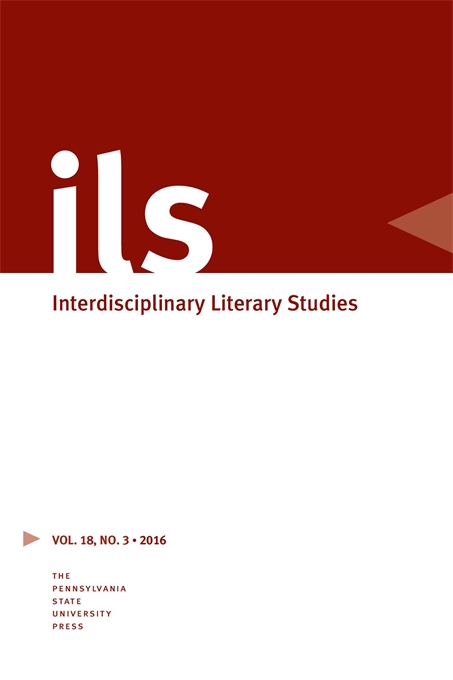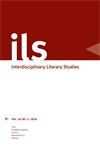
Interdisciplinary Literary Studies
A Journal of Criticism and Theory
James M. Decker, Editor
Kenneth Womack, Editor
Interdisciplinary Literary Studies
A Journal of Criticism and Theory
James M. Decker, Editor
Kenneth Womack, Editor
- Description
- Board
- Submissions
- Pricing
- Indexing
Access current issues through Scholarly Publishing Collective, Project MUSE, or back content on JSTOR.
Interdisciplinary Literary Studies seeks to explore the interconnections between literary study and other disciplines, ideologies, and cultural methods of critique. All national literatures, periods, and genres are welcomed topics.
CALL FOR ABSTRACTS for Special Issue Contaminated Bodies, Contaminated Lands: Transcorporeality in Eco-narratives - See Submissions
Editors
James M. Decker, Illinois Central College, US
Kenneth Womack, Monmouth University, US
Associate Editors
Todd F. Davis, Penn State Altoona
Laura E. Rotunno, Penn State Altoona
Megan Simpson, Penn State Altoona
Editorial Board
William Baker, Northern Illinois University, US
David Bartine, SUNY Binghamton
Kirstie Blair, University of Stirling
John Brannigan, University College, Dublin
Olga Cooke, Texas A&M University
John Dern, Temple University
Nancy Easterlin, University of New Orleans
Ranjan Ghosh, North Bengal University
David Gorman, Northern Illinois University
John Kimsey, DePaul University
Peter Kitson, University of Dundee
Amy Mallory-Kani, SUNY Albany
Ian Marshall, The Pennsylvania State University Altoona
William Nelles, University of Massachusetts Dartmouth, US
Anna Peak, Temple University
Mohammad A. Quayum, International Islamic University Malaysia
David Rampton, University of Ottawa
Ruth Robbins, Leeds Beckett University
Elaine Treharne, Stanford University
Julian Wolfreys, University of Portsmouth
To submit a manuscript to the editorial office, please visit http://www.editorialmanager.com/interlitstudies/ and create an author profile. The online system will guide you through the steps to upload your manuscript.
All submissions must be written in English. Contributors may also propose potential subjects for review essays or interviews. Please send all manuscript submissions to the Editors through the journal's online submission and peer review system above.
Please review the complete submission guidelines prior to submitting a manuscript.
CALL FOR ABSTRACTS for Special Issue Contaminated Bodies, Contaminated Lands: Transcorporeality in Eco-narratives.
Editors
Dr. Paula Wieczorek, Assistant Professor, Department of English Studies, University of Information Technology and Management, Poland. E-mail: pwieczorek@wsiz.edu.pl
Dr. Nikoleta Zampaki, Postdoctoral Researcher, Faculty of Philology, School of Philosophy, National and Kapodistrian University of Athens, Greece. E-mail: nikzamp@phil.uoa.gr
Outline
In an era of escalating ecological crises, from industrial pollution to global pandemics, the boundaries of the human body feel more permeable than ever. The history of environmental disasters makes this porosity undeniable. At Love Canal in the 1970s, residents discovered their homes and school had been built on a chemical landfill, as toxic sludge seeped into basements and caused alarming health effects. In Flint, Michigan, in 2014, lead from corroded water pipes leached into drinking water, poisoning thousands through the most basic act of turning on a tap. After Chernobyl (1986) and Fukushima (2011), radioactive isotopes entered food chains and silently accumulated in human tissue, making exposure both invisible and enduring. These cases demonstrate that contamination does not remain “out there” but crosses into the most intimate spaces of human life, collapsing the boundary between contaminated lands and contaminated bodies.
The concept of “transcorporeality,” pioneered by Stacy Alaimo (2010), offers a crucial framework for understanding this condition. It posits that human bodies are not discrete, sealed entities but fundamentally porous systems, continuously co-constituted through material interchange with the more-than-human world. For Alaimo, “transcorporeality” is crystallized through a personal experience: after mailing a lock of her hair to Greenpeace, she received test results showing the precise level of mercury inside her body. This moment revealed that pollution is not confined to distant landscapes or abstract data sets but circulates directly through human tissue (Alaimo 2012). Her own hair became a material archive of industrial effluents, demonstrating that the boundaries between body and environment is permeable and that ecological harm is literally inscribed on the self. In this sense, environmentalism could no longer be framed as an external concern for “nature out there,” but as an unavoidable condition of embodied existence. Transcorporeality thereby dismantles Cartesian dualism by rejecting the separation of mind and body, culture and nature, subject and object, and insisting instead on entanglement.
Alaimo’s insights have been expanded by other thinkers. Karen Barad (2007) introduces “intra-action” to emphasize that bodies and environments emerge through relational entanglements. Donna J. Haraway’s notions of “natureculture” and the “cyborg” (1991, 2016) dismantle binaries of human/animal and organism/machine, illuminating the hybrid materiality of toxic embodiment (e.g., Cielemecka and Åsberg 2019). Astrida Neimanis (2017) highlights our status as “bodies of water” and theorizes “weathering” as the inscription of climate change and environmental harm into flesh across generations. Together, these approaches demonstrate that transcorporeality is not a metaphor but a lived condition of the Anthropocene.
Literature and cultural production respond to this reality by making perceptible what often remains hidden or denied. They expose the “slow violence” (Nixon 2011) of toxins—forms of harm that unfold gradually, invisibly, and across generations, from lead settling in children’s bones to radioactive isotopes altering DNA. They highlight the epistemic struggles over whose knowledge counts, showing how residents’ embodied testimonies of rashes, headaches, or miscarriages are frequently dismissed by officials as anecdotal or unscientific, even though such testimony constitutes vital evidence of contamination. They also bring to the fore the embodied inequalities that define sacrifice zones, where low-income and marginalized communities disproportionately bear the burdens of environmental harm (Byrnes 2022).
Memoirs, oral histories, and documentaries render visible the suffering of those whose bodies have become unwilling archives of toxicity, while speculative fiction and ecopoetics imagine contaminated futures and multispecies entanglements that extend beyond the human. In this way, cultural narratives do not merely document harm; they transform lived experience into testimony, critique, and resistance (e.g., Armiero et al. 2019). They insist that contamination is not only a scientific or political issue but also an aesthetic and ethical one, demanding new forms of storytelling to account for porous bodies and toxic environments.
In light of these frameworks and representations, this interdisciplinary special issue of Interdisciplinary Literary Studies. A Journal of Criticism and Theory seeks to explore how eco-narratives articulate the entanglement of contaminated bodies and contaminated lands. We invite contributions that explore literary, cultural, intermedial, cinematic and testimonial responses to contamination through the lens of transcorporeality and allied theories. By foregrounding the porous and vulnerable body, this issue aims to illuminate the aesthetics, ethics, and politics of contamination in an era of ecological crisis. Possible topics include, but are not limited to:
?Theoretical framework of transcorporeality: e.g, ecocriticism, ecofeminism, posthumanism, new materialism, postcolonial studies, etc.
? Econarratives of precarity, vulnerability, environmental (in)justice and embodied inequality, toxicity, sacrifice zones, and “hazardous hope” in literary, cultural, intermedial studies, etc.
? Literary, testimonial, and oral econarratives of contamination (e.g., Love Canal, Flint, Chernobyl, Bhopal, Fukushima, etc.)
?Aesthetics of permeability and slow violence in environmental storytelling
? Speculative fiction (e.g., Cli-fi, oil fiction, Solarpunk etc.) and toxic futures: imagining contamination, survival, and multispecies entanglements
? Indigenous and decolonial perspectives on polluted lands and waters
? Intergenerational trauma and the inheritance of toxic exposure
? Ecopoetics and nonhuman agencies of contamination
References
Alaimo, Stacy. “Sustainable This, Sustainable That: New Materialisms, Posthumanism, and Unknown
Futures.” PMLA 127, no. 3 (2012): 558–564. http://www.jstor.org/stable/41616846
—. Bodily Natures: Science, Environment, and the Material Self. Indian University Press, 2010.
Armiero, Marco et al. “Toxic Bios: Toxic Autobiographies: A Public Environmental Humanities
Project.” Environmental Justice 12, no. 1 (2019): 7–11. https://doi.org/10.1089/env.2018.0019
Barad, Karen. Meeting the Universe Halfway. Quantum Physics and the Entanglement of Matter and
Meaning. Duke University Press, 2007.
Byrnes, Delia. “Ecocriticism and the Body.” In The Cambridge Companion to American Literature
and the Body, edited by Travis M. Foster. Cambridge University Press, 2022, pp. 245–258.
Cielemecka, Olga and Cecilia Åsberg. “Introduction: Toxic Embodiment and Feminist Environmental
Humanities.” Environmental Humanities 11, no. 1 (2019): 101–107. doi: https://doi.org/10.1215/22011919-7349433
Haraway, J. Donna. Staying with the Trouble. Making Kin in the Chthulucene. Duke University Press,
2016.
—. Simians, Cyborgs, and Women. The Reinvention of Nature. Routledge, 1991.
Neimanis, Astrida. Bodies of Water: Posthuman Feminist Phenomenology. Bloomsbury, 2017.
Nixon, Rob. Slow Violence and the Environmentalism of the Poor. Harvard University Press.
Guidelines: The working language is English. Please send your topic’s title, abstract of 200-300 words including a short list of references, five keywords, short bio (100-200 words) including your ORCiD, your full affiliation(s) and e-mail(s) in one Word document (.doc / .docx) titled only with your surname to pwieczorek@wsiz.edu.pl and nikzamp@phil.uoa.gr by 30 November 2025 at the very latest. For any additional information or questions regarding the project, please contact the Editors.
Institutional Online - $240.00
Institutional Print - $250.00
Institutional Online & Print - $351.00
Institutional Single Issue - $70.00
Individual Online - $69.00
Individual Print - $72.00
Individual Online & Print - $101.00
Individual Single Issue - $25.00
Outside US add Shipping & Handling - $25.00
Web of Science Core Collection: Emerging Sources Citation Index
European Reference Index for the Humanities and Social Sciences (ERIH PLUS)
IBZ
MLA International Bibliography
Scimago Journal & Country Rank
Scopus
Mailing List
Subscribe to our mailing list and be notified about new titles, journals and catalogs.



